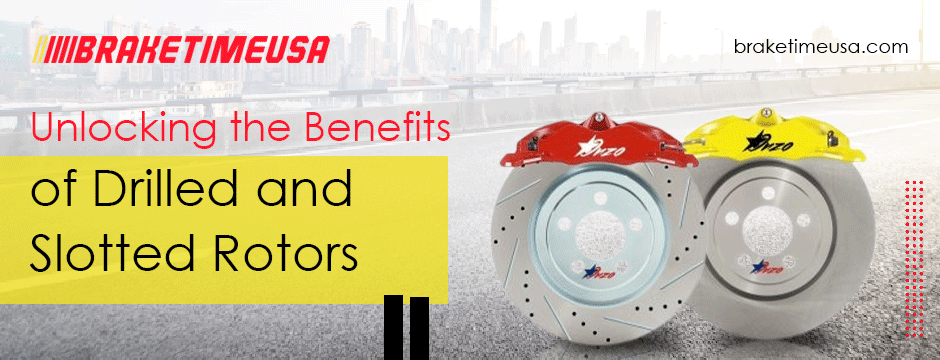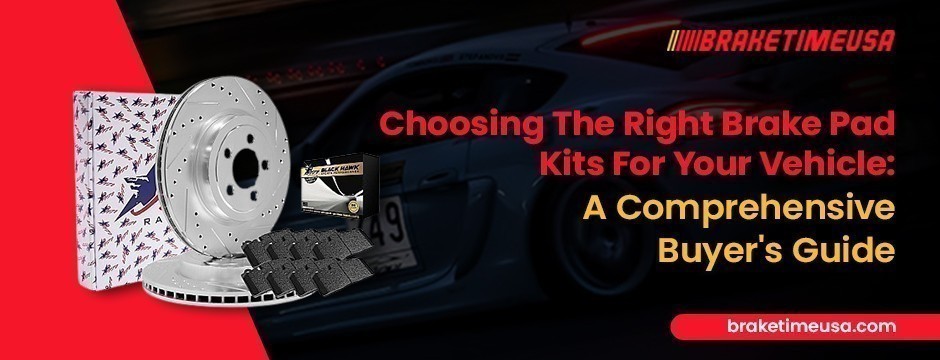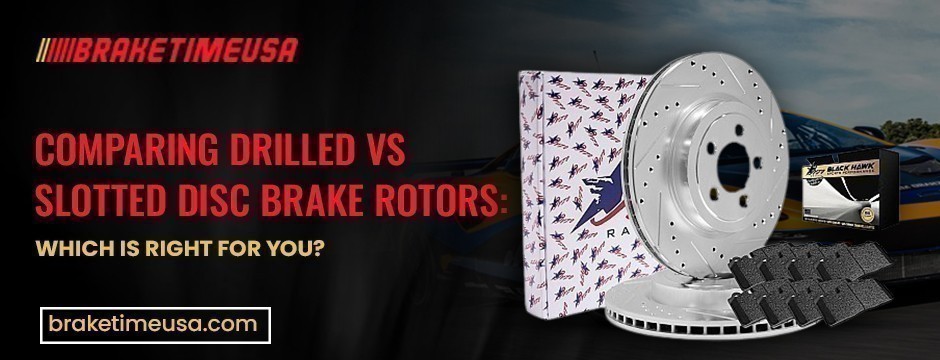Your cart is empty
Subtotal:$0.00
Ensuring the proper maintenance of your vehicle's braking system is not only a matter of practicality but a fundamental aspect of responsible vehicle ownership. The braking system, comprising components like brake pads and rotors, plays a pivotal role in the safety and performance of your vehicle. In this comprehensive guide, we will embark on a step-by-step exploration of how to check brake pads and rotors. This process, when done routinely, empowers you to identify potential issues early, optimize your brake system's efficiency, and ultimately contribute to a safer driving experience.
Before delving into the practical steps of inspecting brake pads and rotors, it's crucial to establish why this maintenance is of paramount importance. Brake pads and rotors are not mere automotive components; they are the frontline defenders responsible for slowing down and bringing your vehicle to a halt. The braking system's efficacy is directly tied to the proper functioning of these components.
Safety Assurance: The safety of you, your passengers, and others on the road hinges on the reliability of your vehicle's braking system. Brake pads and rotors work in tandem to convert the kinetic energy of your moving vehicle into heat, effectively slowing it down. Regular maintenance ensures that these components are in optimal condition, reducing the risk of brake failure and enhancing overall safety on the road.
Performance Optimization: A well-maintained braking system translates to enhanced vehicle performance. Effective braking not only ensures safety but also contributes to the overall driving experience. Timely replacement of worn brake pads and rotors prevents a decline in braking performance, allowing you to maintain control and responsiveness while driving.
Lifespan Extension: Brake pads and rotors undergo significant wear and tear during their normal operation. Routine maintenance involves inspecting these components for signs of wear and addressing issues promptly. By doing so, you extend their lifespan, optimizing your investment in quality braking components and minimizing the frequency of replacements.
Prevention of Safety Hazards: Neglected brake pads and rotors can pose safety hazards, potentially leading to accidents or compromised vehicle control. Routine maintenance acts as a preventive measure, identifying potential problems before they escalate into critical issues. Addressing minor concerns during routine checks mitigates the risk of sudden brake failure or other safety-related problems.
Performing a systematic and thorough check of your brake pads and rotors is essential for maintaining the health and functionality of your vehicle's braking system. Follow this step-by-step guide to ensure a comprehensive inspection:
Gather Necessary Tools: Begin by collecting the essential tools required for the inspection. This includes a car jack, lug wrench, flashlight for better visibility, and a reliable tire pressure gauge. Having these tools at your disposal ensures a smooth and efficient inspection process.
Ensure Safety First: Prioritize safety before commencing the inspection. Park your vehicle on a flat, stable surface to prevent any inadvertent movement during the process. Engage the parking brake to secure the vehicle in place, and don appropriate safety gear such as gloves and safety glasses to protect yourself during the inspection.
Wheel Removal: Loosen the lug nuts on the wheel you intend to inspect using a lug wrench. This preliminary step facilitates the removal of the wheel for a more comprehensive examination. Lift the vehicle using the car jack and carefully remove the wheel, exposing the braking components for inspection.
Examine Brake Pads: Locate the brake caliper, which houses the brake pads. Inspect the thickness of the brake pads, as they play a critical role in friction and stopping power. If the pads measure less than a quarter of an inch in thickness, consider replacing them. Additionally, ensure that the pads wear evenly; uneven wear patterns could signify issues with the caliper or guide pins that require attention.
Check Rotor Surface: Direct your attention to the rotor surface. Inspect it for signs of wear, scoring, or grooves. Ideally, the rotor should exhibit a smooth and even surface. Deep grooves or scoring suggest wear beyond acceptable limits, necessitating either resurfacing or replacement of the rotors.
Inspect for Heat Spots: Look for discolored patches on the rotor surface known as heat spots. These indicate uneven heat distribution during braking and may compromise the overall performance of the braking system. Identifying heat spots early allows for timely intervention and prevents potential issues.
Measure Rotor Thickness: Utilize a micrometer to measure the thickness of the rotor. Compare the measurement to the manufacturer's specifications. If the rotor is excessively thin, it may be prone to warping under heat stress and should be replaced to maintain optimal braking performance.
Check for Brake Fluid Leaks: Inspect the area around the brake caliper and brake lines for any signs of brake fluid leaks. Fluid leaks can compromise braking efficiency and indicate potential issues within the brake system. Addressing leaks promptly is crucial for maintaining a safe and reliable braking system.
Assess Brake Pad Hardware: Ensure that the brake pad hardware, including clips and springs, is in good condition. Damaged or missing hardware can lead to noise during braking and contribute to uneven pad wear. Checking and maintaining this hardware ensures smooth and quiet operation.
Reassemble and Repeat: After completing the inspection on one wheel, carefully reassemble it by securing the lug nuts. Tighten the lug nuts with the lug wrench and repeat the entire process for the remaining wheels. This thorough inspection ensures that all components of the braking system are examined, promoting overall safety and performance.
Ensuring the longevity and optimal performance of your vehicle's braking system extends beyond periodic inspections. Incorporating routine maintenance practices enhances the reliability of brake pads and rotors, contributing to a safer and more efficient driving experience. Follow these maintenance tips for comprehensive care:
Follow Manufacturer Recommendations: Adhering to the manufacturer's guidelines regarding brake pad and rotor replacement intervals is fundamental. Consult your vehicle's owner's manual for specific recommendations tailored to your make and model. Manufacturers provide insights into the expected lifespan of brake components, allowing you to plan replacements proactively and maintain optimal braking efficiency.
Brake Fluid Inspection: Periodically inspecting the brake fluid level and quality is crucial for overall brake system health. Check the brake fluid reservoir under the hood and ensure it meets the recommended level. Additionally, assess the fluid's clarity; brake fluid should be transparent, not cloudy or discolored. If needed, top up or replace the brake fluid according to the manufacturer's specifications to maintain hydraulic integrity within the braking system.
Listen for Brake Noise: Actively listen for any unusual noises while applying the brakes, such as squealing, grinding, or metallic sounds. Unusual sounds often indicate worn brake pads or potential issues with other braking components. Addressing these audible warning signs promptly can prevent further damage and ensure that the braking system operates smoothly.
Monitor Brake Warning Lights: Stay vigilant for the illumination of the brake warning light on the dashboard. The brake warning light serves as an indicator for various brake-related issues, including low brake fluid levels, worn brake pads, or potential malfunctions within the braking system. If the brake warning light activates, promptly investigate and address the underlying problem to maintain the safety and functionality of your brakes.
Professional Inspection: While conducting routine checks is essential, seeking the expertise of a professional mechanic during regular maintenance services is equally important. Professional inspections provide a thorough examination of the entire brake system, including components not easily accessible during DIY checks. A skilled mechanic can detect potential issues early, offer expert insights, and recommend necessary interventions to ensure the optimal performance of your brakes.
Regularly checking brake pads and rotors is not just a maintenance task; it is a commitment to safety, longevity, and proactive vehicle ownership. This comprehensive guide on how to check brake pads and rotors serves as a valuable resource, empowering you to conduct thorough inspections and make informed decisions about the maintenance of your braking system. By incorporating these practices into your vehicle care routine, you actively contribute to a safer driving experience while prolonging the life and efficiency of essential braking components. To find out more, follow us at Braketime!
 Mar 27, 2024Unlocking the Benefits of Drilled and Slotted Rotors
Mar 27, 2024Unlocking the Benefits of Drilled and Slotted Rotors Mar 22, 2024Choosing The Right Brake Pad Kits For Your Vehicle: A Comprehensive Buyer's Guide
Mar 22, 2024Choosing The Right Brake Pad Kits For Your Vehicle: A Comprehensive Buyer's Guide Mar 18, 2024Exploring Different Types of Rear Brake Rotors
Mar 18, 2024Exploring Different Types of Rear Brake Rotors Mar 6, 2024Comparing Drilled vs. Slotted Disc Brake Rotors: Which Is Right for You?
Mar 6, 2024Comparing Drilled vs. Slotted Disc Brake Rotors: Which Is Right for You?
 Feb 5, 2024Comprehensive Guide on How To Check Brake Pads and Rotors for Optimal Maintenance
Feb 5, 2024Comprehensive Guide on How To Check Brake Pads and Rotors for Optimal Maintenance© 2023 - 2024 Braketimeusa. All rights reserved.
